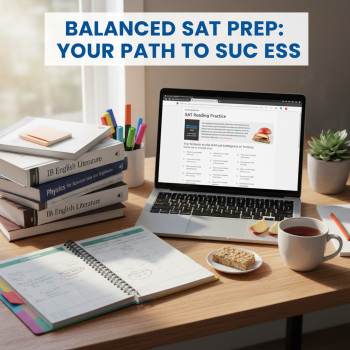Why long-term SAT readiness matters more than a sprint
Picture this: two students sit down for the Digital SAT. One stayed up nights in the final week, doing practice tests back-to-back, relying on energy drinks and adrenaline. The other spent months steadily practicing—working a little each week on vocabulary, pacing, and problem types—and took one or two full practice tests in the final month. Which one is more likely to walk out of the test center calm, confident, and ready to click “submit”?
The answer is obvious for anyone who’s studied learning, memory, and test performance: the steady, methodical student almost always wins. Long‑term SAT readiness isn’t just a test-prep cliché. It’s a collection of evidence-backed habits and strategies that improve retention, reduce anxiety, and let you demonstrate the thinking colleges want to see.
Short-term cramming vs long-term readiness: the real differences
Cramming can produce a temporary boost in recall, but it rarely builds the flexible problem-solving and reading stamina the SAT requires—especially the Digital SAT, which emphasizes strategy and adaptive sections. Long-term readiness builds:
- Deep conceptual understanding (so you can adapt when a question looks unfamiliar)
- Automaticity with routine skills (algebra manipulations, grammar conventions, reading strategies)
- Test-day routines that reduce stress (sleep, pacing, device setup for the Digital SAT)
- Confidence from repeated exposure to question types and timed practice
How the Digital SAT changes the game — and why long-term work helps
The Digital SAT brought a few practical changes: it’s delivered on a secure app, sections are shorter and adaptive, and pacing looks a little different. Those shifts make long-term preparation even more valuable. Instead of training only for a single four-hour marathon, you train for consistent performance across adaptive sessions, quicker decision-making, and the discipline to manage a device-based testing environment.
Real benefits of preparing early for the Digital SAT
- Familiarity with the testing app and device setup reduces logistical stress on test day.
- Adaptive formats reward consistent performance—practicing gradually helps you avoid big swings in accuracy.
- Pacing skills improve with repeated timed practice; you learn to allocate time to hard versus easy items.
- Reading stamina and mathematical fluency grow slowly but steadily; the Digital SAT’s reading passages reward calm, focused reading more than last-minute tricks.
Practical long-term plan: what a smart year of SAT prep looks like
Below is a practical timeline you can adapt to your school year, workload, and goals. You don’t need to follow every detail—think of this as a framework that turns a vague “I should study” into a realistic, low-stress plan.
12 months out: build the foundation
- Take a diagnostic practice test to identify strengths and gaps.
- Create a modest weekly routine: 3–5 focused sessions (30–60 minutes each).
- Work on fundamentals: core algebra, grammar rules, close-reading habits.
- Track progress with short quizzes and low-stakes timed drills.
6 months out: refine skills and pacing
- Start doing at least one full-length practice test every 3–4 weeks.
- Analyze mistakes thoroughly—don’t just mark them; understand why.
- Build a vocabulary strategy that’s about context, not flashcards alone.
- Introduce mixed timed sections to simulate the adaptive experience.
2–3 months out: simulate and optimize
- Increase full test frequency to every 1–2 weeks if possible.
- Work on energy management: sleep schedule, nutrition, and mental rehearsal.
- Polish strategies for guessing, flagging, and time allocation.
- Do a few practice sessions on the actual testing device/app to remove surprises.
Final 2 weeks: taper and focus
- Cut volume—prioritize targeted practice over new content.
- Complete one final full practice test 7–10 days before the real test.
- Create a test-day checklist (device charged, Bluebook or testing app updated, ID, snacks where allowed).
- Adopt calming rituals: breathing exercises, walk outside, and a consistent sleep routine.
Examples and micro-strategies that add up over months
Long-term readiness is the sum of many small choices. Here’s how tiny, repeated actions become big improvements:
Example 1: daily 20-minute reading habit
Read one high-quality news or feature article every day and summarize its main idea in a sentence. Over months, this boosts comprehension speed, inference skills, and the ability to spot an author’s tone—exactly the skills tested on the Reading and Writing sections.
Example 2: weekly problem-type focus
Pick one math topic per week (linear functions, ratios, circle geometry). Do 10 targeted problems with immediate review. Repeat the cycle monthly. After three months, you’ll see dramatic accuracy gains because mistakes become fewer and more informative.
Table: Sample 6‑Month Weekly Schedule
| Week | Focus | Weekly Time | Key Activity |
|---|---|---|---|
| 1–4 | Fundamentals | 3–5 hours | Diagnostic test, basics practice, short reading habit |
| 5–12 | Skill Building | 4–6 hours | Topic weeks, targeted problem sets, one timed section |
| 13–20 | Practice Tests | 5–8 hours | Full practice test every 3–4 weeks, focused review sessions |
| 21–24 | Polish & Simulate | 6–9 hours | Full tests every 1–2 weeks, device/app simulations, mental prep |
How to make studying sustainable: habits, not heroic effort
Sustainable study beats heroic effort every time. Students who build a few reliable habits—short focused sessions, clear goals, and consistent review—see better scores with less anxiety. Here are practical ways to keep the work manageable and effective.
Micro-sessions with deliberate focus
Block 25–45 minutes for focused work, then take a 5–10 minute break. During the session, remove distractions: put your phone on Do Not Disturb and close unrelated tabs. These micro-sessions are easier to schedule and reduce the temptation to procrastinate.
Weekly review loop
Every week, spend 30–60 minutes reviewing all mistakes from the week’s practice. Categorize errors (careless, content gap, misreading, pacing) and design the next week’s practice to address the most common categories.
Use data, but don’t drown in it
Keep a simple tracker: test date, score, weakest topic, and one actionable goal for the next week. Data helps you prioritize, but obsessing over every point can be counterproductive.
Why personalized help accelerates long-term readiness
One reason steady preparation works is that it’s flexible: you can customize it to your learning style and schedule. That’s where personalized tutoring shines. A good tutor helps you build the right habits, spot repeating mistakes, and keep momentum.
When individualized guidance is worth it
- You’ve plateaued despite regular practice.
- You need structure to stay consistent.
- You want a tailored study plan that fits your courses and commitments.
Sparkl’s personalized tutoring can fit naturally into a long-term plan: 1-on-1 guidance, tailored study plans, expert tutors, and AI-driven insights help you focus effort where it matters most without wasting precious hours. When it’s used as an accountability and strategy partner—not a last-minute fix—it amplifies the benefits of long-term readiness.
Managing anxiety and test day logistics — months ahead, not minutes before
Test anxiety is often fueled by uncertainty. The more you plan and simulate in advance, the fewer surprises you’ll face on test day. Here’s how long-term prep reduces both the unknowns and the emotional spikes.
Practice the full experience
- Do practice tests on the same device type you’ll use when possible, and learn the app’s tools (flagging, navigation).
- Practice test-day routines: sleep, breakfast, travel time, and a warm-up section to get your brain humming.
- Simulate disruptions occasionally—like starting a test after an interruption—so you can practice regaining focus.
Mental training that compounds
Small mental rehearsals performed regularly—visualizing the testing room, breathing through a difficult question, or using a brief mindfulness routine—reduce the physiological reaction to stress. Over time, these mental skills become automatic and stabilize performance.
Common pitfalls to avoid during long-term prep
- Studying without a plan: random practice hurts more than it helps. Create a rhythm and adjust every few weeks.
- Ignoring mistakes: repeating the same error without analyzing why stalls progress.
- Over-reliance on passive review: re-reading notes is a low-yield activity—active problem-solving, self-testing, and explaining concepts aloud are far better.
- Overtraining before the test: cramming in the final days increases fatigue and reduces clarity.
How to measure progress realistically
Progress isn’t linear—you will see jumps and plateaus. Use a combination of measures:
- Scaled practice test scores to measure overall trajectory.
- Accuracy and time-per-question by problem type to identify skill gains.
- Self-assessments of confidence and test-day calmness.
Simple progress dashboard
| Metric | How to track | Why it matters |
|---|---|---|
| Practice test score | Full-length every 2–4 weeks | Shows overall readiness and pacing ability |
| Percent correct by topic | After every practice test | Pinpoints content weaknesses |
| Average time per question | Timed sections or app analytics | Helps tune pacing strategy |
Real-world context: how colleges see steady preparation
Colleges look for students who can demonstrate consistent achievement and growth. A steady, sustainable SAT preparation process improves your chance to reflect your academic potential. More importantly, the skills you develop—clear reading, logical problem solving, disciplined study—carry into college work and beyond. Long-term readiness is not just about one score; it’s about building habits that serve your entire academic future.
Putting it into action: a one-month starter plan
If you’re ready to stop guessing and start building momentum, try this approachable 4-week starter plan designed for students who want to shift from last-minute to long-term thinking.
- Week 1: Take a diagnostic test; identify two weak areas; commit to 3 focused sessions of 45 minutes.
- Week 2: Do topic-based practice on weak areas; build a 20-minute daily reading habit; analyze mistakes thoroughly.
- Week 3: Time a mixed practice section; practice one full-length test under realistic conditions; refine pacing.
- Week 4: Review patterns in errors; meet with a tutor or mentor to create a 3‑month plan; schedule your next practice test.
Closing thoughts: study like you mean it—slowly
Long-term SAT readiness is less glamorous than a last-minute cram session, but it is dramatically more effective. By investing in small, consistent habits and using targeted practice, you build the cognitive stamina and strategic instincts that the Digital SAT rewards. And if you find yourself stuck, consider personalized help—Sparkl’s 1-on-1 guidance, tailored study plans, expert tutors, and AI-driven insights can slot into a months-long plan to speed progress and keep you accountable.
Start early, be consistent, and view the SAT as a long-term project rather than a single battle. Do that, and you’ll arrive at test day ready—not frantic—able to show the best version of your academic self.














No Comments
Leave a comment Cancel